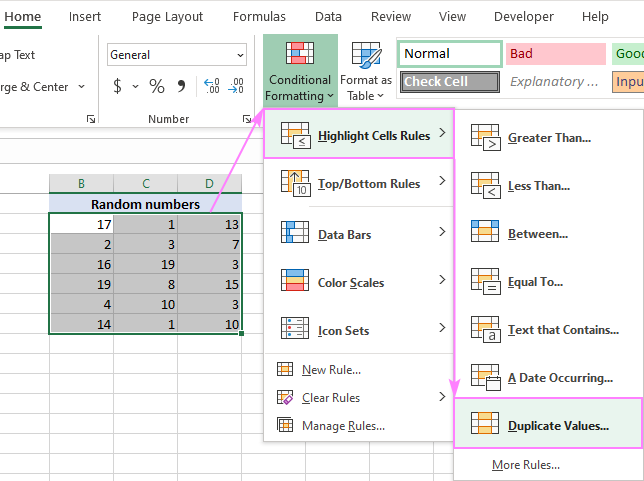5 Ways to Eliminate Excel Duplicates but Keep One

Excel is a powerful tool for managing data, but often, datasets can become cluttered with duplicate entries which can skew results and make data analysis more challenging. Ensuring your data is clean and duplicates are managed effectively is crucial for accurate data processing. Here are five detailed methods to remove duplicates in Excel while retaining one instance of each.
1. Using the “Remove Duplicates” Feature

Excel's built-in "Remove Duplicates" feature is perhaps the simplest and most straightforward method to eliminate duplicate entries.
- Steps to Follow:
- Select the range of cells from which you want to remove duplicates.
- Go to the Data tab on the Ribbon.
- Click on Remove Duplicates in the Data Tools group.
- In the dialog box, choose the columns you want to check for duplicates.
- Select OK and Excel will remove all but the first instance of each duplicate.
🔄 Note: This method will delete duplicate rows, preserving the first occurrence in the selected range.
2. Using Advanced Filtering

Advanced filtering in Excel can be used not only to sort but also to manage duplicates:
- Steps to Follow:
- Select your data range.
- Go to the Data tab and choose Advanced under the Sort & Filter group.
- In the dialog box:
- Select the action 'Filter the list, in-place' or 'Copy to another location'.
- Specify 'Unique records only' under the Action options.
- Click OK to apply the filter.
⚠️ Note: This method keeps duplicates in the data set; however, they will be filtered out of view, which might not be ideal for all users.
3. Using Conditional Formatting to Highlight Duplicates

This method helps in visualizing duplicates before taking further action:
- Steps to Follow:
- Select your dataset.
- Navigate to the Home tab, then click on Conditional Formatting > Highlight Cells Rules > Duplicate Values.
- Choose a format to highlight duplicates, then OK.
- Once highlighted, you can manually delete the duplicates or use filtering.
4. Creating a Pivot Table

Pivot Tables offer a unique way to manage duplicates by summarizing data:
- Steps to Follow:
- Select your data.
- Go to the Insert tab and click on PivotTable.
- Choose the range and click OK.
- Drag the column(s) with potential duplicates to the Row Labels area, ensuring each row value is unique.
👁️ Note: Pivot Tables do not remove duplicates; they group the data, showing only unique values, which can then be extracted into a new dataset if needed.
5. Using Formulas and Functions

Utilizing Excel's functions like UNIQUE or a combination of COUNTIF with filtering can provide a more dynamic approach to removing duplicates:
- Using UNIQUE Function:
- Available in Excel 365 or later, use
=UNIQUE(A1:A100)where A1:A100 is the range of cells containing data.
- Available in Excel 365 or later, use
- Using COUNTIF and Filtering:
- In an adjacent column, use the formula
=COUNTIF($A$1:$A$100, A1)to count occurrences. - Filter your data for cells where this formula returns 1 (indicating unique values) and copy these to another location.
- In an adjacent column, use the formula
Each method has its advantages, suited to different scenarios:

| Method | Advantage | Best Use Case |
|---|---|---|
| Remove Duplicates | Quick and simple | When you need to remove all but one of duplicate entries immediately. |
| Advanced Filter | Does not delete data | When you need to analyze data with and without duplicates or when data preservation is essential. |
| Conditional Formatting | Visual tool for manual removal | When you want to visually identify and manually remove or process duplicates. |
| Pivot Table | Summarize and group data | Useful for analyzing unique data values or when creating reports. |
| Formulas | Dynamic data management | When you need to automatically keep track of changes or when using spreadsheets with complex data interactions. |
After exploring these methods, it's clear that Excel provides several robust ways to manage duplicates in your datasets, each with its own set of benefits. Whether you need a quick fix, a non-destructive view, or a more complex data management strategy, Excel has you covered. Understanding which method to apply when can streamline your data processing, making your work with Excel more efficient and accurate.
Will removing duplicates affect my formulas?
+Removing duplicates might affect formulas if those formulas rely on the rows with duplicates. It’s important to check your formulas after removing duplicates to ensure they still function correctly.
How can I recover removed duplicates?
+Excel does not have an in-built feature to undo the removal of duplicates once executed. Always make a copy of your original data or use advanced filtering instead, which does not delete data.
Can I remove duplicates based on multiple columns?
+Yes, both the “Remove Duplicates” feature and Advanced Filtering allow you to specify multiple columns to identify duplicates. This ensures that only entries identical across all specified columns are removed.
Related Terms:
- excel filter for duplicate values
- excel remove duplicates across columns
- automatically remove duplicates in excel
- quickly remove duplicates in excel
- remove duplicates using excel formula
- excel formula to remove duplicates



